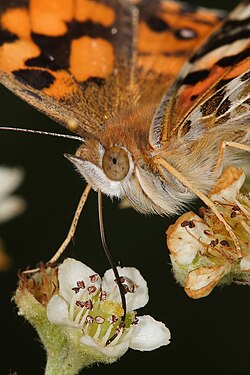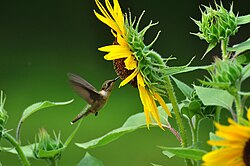Nectarivore

Inzoology,anectarivoreis an animal which derives its energy and nutrient requirements from adietconsisting mainly or exclusively of the sugar-richnectarproduced byflowering plants.
Nectar as a food source presents a number of benefits as well as challenges. It is essentially a solution of (as much as 80%) the simple sugarssucrose,glucoseandfructose,which are easily ingested and digested, representing a rich and efficient source of nutrition. This solution is oftendilutedeither by the plant that produces it or by rain falling on a flower and many nectarivores possess adaptations to effectively rid themselves of any excess water ingested this way.
However, nectar is an incomplete source of nutrition. While it does containproteinsandamino acids,[1]these are found in low quantities, and it is severely deficient in minerals and vitamins.[2]Very few organisms consume nectar exclusively over their whole life cycle, either supplementing it with other sources, particularly insects (thus overlapping withinsectivores) or only consuming it exclusively for a set period.[3]Many species arenectar robbers or nectar thieves,performing no pollination while still consuming nectar. Many species are both nectar robbers and pollinators, depending on the plant species they encounter.
Nectar is produced by flowering plants to attractpollinatorsto visit the flowers and transportpollenbetween them. Flowers often have specialized structures that make the nectar accessible only for animals possessing appropriate morphological structures, and there are numerous examples ofcoevolutionbetween nectarivores and the flowers they pollinate. For example,hummingbirdsandhawkmothshave long narrow beaks that can reach nectar at the bottom of long tubular flowers.[4][5]
The majority of nectar feeders areinsectsorbirds,but instances can also be found in other animal groups.
Insects
[edit]
Nectarivory is extremely common in insects. Key families with large proportions of nectarivores include theColeoptera,Lepidoptera,Diptera,HymenopteraandHemiptera.Some, but not all, are also pollinators: others engage in nectar robbing by avoiding the reproductive organs of plants altogether, particularly those with deepcorollas,by piercing into the base of the flower to reach thenectarydirectly, such ascarpenter beesand secondarilyhoney bees(who consume nectar from holes made by others),[6]as well as ants, who frequently consume nectar and pollen where available despite actively inhibiting germination of pollen at the flowers they visit to the detriment of the plant.[7]

Nectar-feeding insects gain enough water from nectar to rarely need to drink, though adult butterflies and moths may engage inpuddlingin order to obtain dissolved substances not abundant in nectar, particularlysaltsandamino acids.[8] Some flying nectarivores, particularly larger bees, do not lose enough water byevaporationwhile on the wing to offset their high intake due to nectar-feeding, as well as water producedmetabolicallywhile flying. They must excrete while on the wing to prevent water loading, and may wait at the nest entrance to evaporate off some of their water load before flying out.[9]
Arachnids
[edit]There is evidence that some spiders, though normally thought to be exclusivelycarnivorous,consume nectar indirectly by consuming nectarivorous insects, and/or directly from flowers. This behavior is thought to be more common among spiders that live among foliage. A few make nectar their primary food source, such asBagheera kiplingi,a member of thejumping spiders,[10][11][12]while others such as thecrab spiders,feed more rarely and opportunistically. None of the spider groups observed feeding on nectar build webs, they are all wandering species.[13]
Birds
[edit]
Nectar-feeding is widespread among birds, but no species consumes nectar exclusively. Most combine it with insectivory for a mixed diet. Of particular interest are three lineages of specialized nectarivorous birds: the hummingbirds (Trochilidae), sunbirds (Nectariniidae) and honeyeaters (Meliphagidae). These groups have adapted to permit a nectar-central diet, showing higher activity of digestive enzymes which break down sugars, higher rates of absorption of sugars, and altered kidney function. To maintain flight a bird must rapidly excrete much of the water content of the nectar it consumes. A hummingbird's kidneys are capable of rapidly producing large quantities ofhyposmoticurine i.e. urine containing a lower concentration of dissolved substances than the blood.[14]Some other bird groups have one or more similar specializations – for instance, theLories,one group of Australasian parrots within the larger parrot familyPsittacidae,possess similar digestive modifications.[15]These are examples ofparallel evolution. TheHawaiian honeycreepershave several species adapted to feed on nectar. The Hawaiian treeMetrosideros polymorphais heavily dependant on the pollination of the more or less nectarivorous honeycreepers.[16]
Mammals
[edit]
Many species of bat feed on nectar, their lifestyle similar to that of nectarivorous birds. In the Americas there is significant overlap between flowers pollinated by bats and hummingbirds – both need similarly-composed nectar to keep up energy-intensive hovering flight. In this part of the world there is particularly close association between some species of columnarcactiand bat species, who provide pollination in exchange for nectar with composition matching their nutritional needs.[17]Nectarivorous bats might be at particular risk of extinction due to their reliance on particular species of flowering plants.[18]
A single marsupial species, thehoney possum,feeds on nectar and pollen exclusively. It raises fewer young which grow more slowly than other marsupials of its size, because of the time-consuming effort of nectar-drinking from many flowers to support itself. It may spend periods in deep sleep to reduce its need for food, and shows the typical nectarivore adaptations for excess water-removal.[19]
See also
[edit]References
[edit]- ^Nepi M, Soligo C, Nocentini D, Abate M, Guarnieri M, Cai G, Bini L, Puglia M, Bianchi L, Pacini E (2012). "Amino acids and protein profile in floral nectar: Much more than a simple reward".Flora.207(7): 475–481.Bibcode:2012FMDFE.207..475N.doi:10.1016/j.flora.2012.06.002.
- ^Gartrell B (2000). "The Nutritional, Morphologic, and Physiologic Bases of Nectarivory in Australian Birds".Journal of Avian Medicine and Surgery.14(2): 85–94.doi:10.1647/1082-6742(2000)014[0085:TNMAPB]2.0.CO;2.S2CID86118478.
- ^Nicolson S, Fleming P (2014)."Drinking problems on a 'simple' diet: physiological convergence in nectar-feeding birds".J Exp Biol.217(7): 1015–23.doi:10.1242/jeb.054387.hdl:2263/39829.PMID24671960.
- ^Wiens, John A. (1992).The Ecology of Bird Communities: Processes and variations.p. 336.ISBN9780521426350.
- ^Richard, A.J. (1997).Plant breeding systems(Second ed.). Chapman & Hall.ISBN978-0-412-57440-5.
- ^Dedej S, Delaplane K (2005). "Net energetic advantage drives honey bees (Apis mellifera) to nectar larceny inVaccinium asheiReade ".Behavioral Ecology and Sociobiology.57(4): 398–403.Bibcode:2005BEcoS..57..398D.doi:10.1007/s00265-004-0852-z.S2CID10927900.
- ^Hull D, Beattie A (1988). "Adverse effects on pollen exposed to Atta texana and other North American ants: implications for ant pollination".Oecologia.75(1): 153–155.Bibcode:1988Oecol..75..153H.doi:10.1007/BF00378829.PMID28311849.S2CID20674424.
- ^Beck J, Mahlenberg E, Fiedler K (1999). "Mud-puddling behavior in tropical butterflies: in search of proteins or minerals?".Oecologia.119(1): 140–148.Bibcode:1999Oecol.119..140B.doi:10.1007/s004420050770.PMID28308154.S2CID20103546.
- ^Nicolson S (2009)."Water homeostasis in bees, with the emphasis on sociality".J Exp Biol.212(3): 429–434.doi:10.1242/jeb.022343.hdl:2263/13697.PMID19151218.
- ^Mihai, Andrei (Oct 13, 2009)."First (mainly) vegetarian spider found".ZME Science.
- ^Jackson R, Pollard S, Nelson X, Edwards G, Barrion A (2001). "Jumping spiders (Araneae: Salticidae) that feed on nectar".J. Zool.255(1): 1469–7998.doi:10.1017/S095283690100108X.
- ^Meehan J, Olson E, Reudink M, Kyser T, Curry R (2009)."Herbivory in a spider through exploitation of an ant–plant mutualism".Curr. Biol.19(19): 892–893.Bibcode:2009CBio...19.R892M.doi:10.1016/j.cub.2009.08.049.PMID19825348.S2CID27885893.
- ^Taylor R, Pfannenstiel R (2008)."Nectar Feeding by Wandering Spiders on Cotton Plants".Environ. Entomol.37(4): 996–1002.doi:10.1093/ee/37.4.996.PMID18801266.
- ^Nicolson S, Fleming P (2014)."Drinking problems on a 'simple' diet: physiological convergence in nectar-feeding birds"(PDF).J Exp Biol.217(7): 1015–23.doi:10.1242/jeb.054387.PMID24671960.S2CID18006942.
- ^Schweizer M, Güntert M, Seehausen O, Leuenberger C, Hertwig S (2014)."Parallel adaptations to nectarivory in parrots, key innovations and the diversification of the Loriinae".Ecol Evol.4(14): 2045–7758.Bibcode:2014EcoEv...4.2867S.doi:10.1002/ece3.1131.PMC4130445.PMID25165525.
- ^Pratt, H. Douglas; Conant, Shelia (2005-05-12).The Hawaiian Honeycreepers: Drepanidinae.OUP Oxford.ISBN978-0-19-854653-5.
- ^Nassar J, Ramirez N, Linares O (1997). "Comparative pollination biology of Venezuelan columnar cacti and the role of nectar-feeding bats in their sexual reproduction".Am. J. Bot.84(7): 918–927.doi:10.2307/2446282.JSTOR2446282.PMID21708646.
- ^Arita H, Santos-Del-Prado K (1999)."Conservation Biology of Nectar-Feeding Bats in Mexico".J. Mammal.80(1): 31–41.doi:10.2307/1383205.JSTOR1383205.
- ^Richardson K, Wooller R, Collins B (1986). "Adaptations to a diet of nectar and pollen in the marsupialTarsipes rostratus(Marsupialia: Tarsipedidae) ".J. Zool.208(2): 285–297.doi:10.1111/j.1469-7998.1986.tb01515.x.

